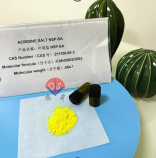Chinese VersionChina Suppliers > Hubei new DE sheng material science and technology co., LTD. > Exploring the Luminescence Conditions of Acridine Salt NSP-SA
- Search Product
-
-
- Region :China/Hubei
- Tel : +86-18971041571
- Fax :
- Email :vickyzhao@whdschem.com
- URL :
- Add :Guanggu United Science and Technology City C8, Ezhou City, Hubei Province
- Details for Exploring the Luminescence Conditions of Acridine Salt NSP-SA
-
Exploring the Luminescence Conditions of Acridine Salt NSP-SA
Category : Other Chemicals/Others

CAS NO : 211106-69-3 EC NO : MF : MW : Specification : yellow powder. Packing : 10g/bottle Product description : Acridine salt NSP-SA is an artificially synthesized organic compound with excellent fluorescence properties. The special functional groups in its molecular structure endow it with strong fluorescence emission ability, making it widely used in fields such as biological imaging and drug tracking. Luminescent conditions 1. Excitation light source: The luminescence of acridine salt NSP-SA first requires a suitable excitation light source. Usually, ultraviolet or blue light can be used as its excitation light source. When the energy of the photon matches the energy difference of the acridine salt NSP-SA molecule, the molecule will absorb the photon and transition from the ground state to the excited state. 2. Temperature: Temperature also has a significant effect on the luminescence of acridine salt NSP-SA. Generally speaking, under room temperature conditions, the fluorescence intensity of acridine salt NSP-SA is relatively stable. However, when the temperature is too high or too low, the vibration and energy level structure of the molecule will change, thereby affecting fluorescence emission. 3. Solvent environment: Factors such as solvent polarity and pH can also affect the luminescence of acridine salt NSP-SA. Usually, solvents with lower polarity are more conducive to fluorescence emission, while changes in pH may affect the ionization state of molecules, thereby affecting fluorescence intensity. Uses : Chemiluminescence reagent Synonyms : NSP-AS;
- more>>Other Products
-
- • Biological buffer 3- [N, N-di (hydroxyethyl) amino] -2-hydroxypropanesulfonic acid DIPSO
- • Luminol Sodium Salt
- • 4-Aminophthalhydrazide
- • acridinium ester DMAE-NHS
- • acridinium ester NSP-DMAE-NHS
- • Acridine hydrochloride NSP-SA
- • Acridine hydrochloride NSP-SA-NHS
- • NSP-SA-ADH
- • acridinium ester ME-DMAE-NHS TOOS; 3-(N-Ethyl-3-Methylanilino)-2-Hydroxypropanesulfonic Acid Sodium Salt
- • TOPS; Sodium 3-(N-Ethyl-3-Methylanilino)Propanesulfonate; N-Ethyl-N-Sulfopropyl-M-Toluidine Sodium Salt
- • ADOS Sodium 3-(Ethyl(3-Methoxyphenyl)Amino)-2-Hydroxypropane-1-Sulfonate Dihydrate
- • ADPS N-Ethyl-N-(3-Sulfopropyl)-3-Methoxyaniline Sodium Salt
- • ALPS N-Ethyl-N-(3-Sulfopropyl)Aniline Sodium Salt; Sodium 3-(Ethyl(Phenyl)Amino)Propane-1-Sulfonate; Sodium
- • DAOS; Sodium 3-((3,5-Dimethoxyphenyl)(Ethyl)Amino)-2-Hydroxypropane-1-Sulfonate
- • HDAOS; N-(2-Hydroxy-3-Sulfopropyl)-3,5-Dimethoxyaniline Sodium Salt
- • MADB N,N-Bis(4-Sulfobutyl)-3,5-Dimethylaniline Disodium Salt
- • MAOS N-Ethyl-N-(2-Hydroxy-3-Sulfopropyl)-3,5-Dimethylaniline Sodium Salt Monohydrate
- • DAB 3,3',4,4'-Biphenyltetramine Tetrahydrochloride